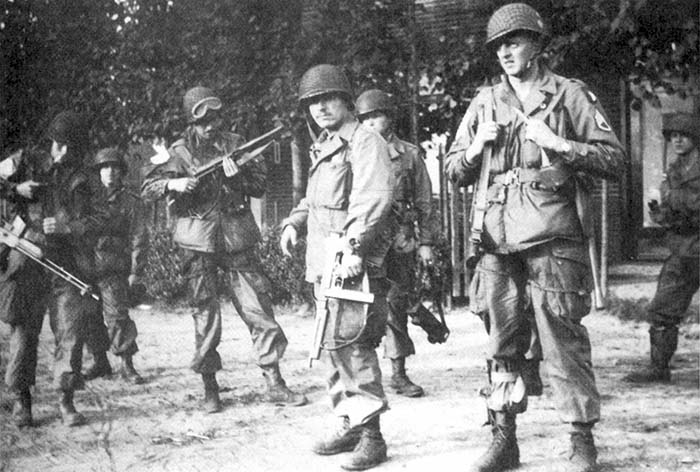By Carl H. Cartledge, Jr.
In his first article, Carl H. Cartledge Jr. introduced the reader to Col. Howard Johnson’s training techniques. In writing his own book in his head, Col. Johnson combined JEB Stuart and Sun Tsu. Before hostilities, JEB Stuart made his men practice and practice until they were ‘confident that they were better than the enemy.’ Sun Tsu said ‘Every battle is won before it is fought’. By the Invasion of Holland, Col. Johnson had perfected his S-2 Recon and Intelligence Teams. The specialized soldiers therein numbered thirty-seven. They were intelligence but not intelligence operatives. They were intelligence soldiers, a concept unique in 1944.
In this article, Carl Cartledge first introduces some of the men who served with him. Each of these men possessed unique skills and sometimes employed conventional weapons uniquely. He then describes some of the fighting around the Watch Tower at Heteren, Holland in early October 1944. He concludes the article with an expanded section from Frank Iannamico’s new book The German MP-40 Maschinepistole, now available from Moose Lake Publishing.
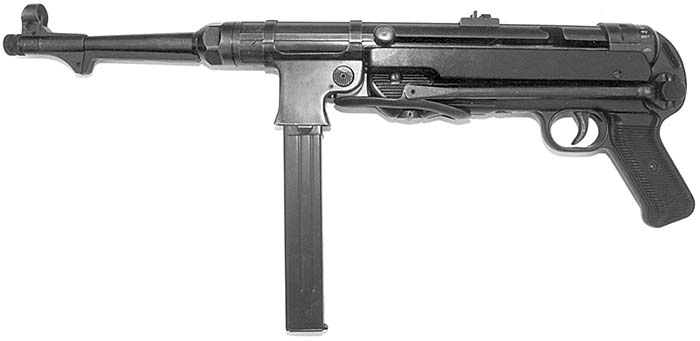
Though many succeeded and joined it in later life, the reader should know this up front. The men I served with weren’t the Rotary Club. They were, and for me always shall be, the finest and bravest men that I have ever known. Under the leadership of Col. Howard Johnson and by their wit and soldiery, they invented a new kind of warfare. Should our country ever again face the peril that it did in 1943, it is my fervent prayer that America will see their like and the like of Johnson again
Robert O. Nikolai of Chillicothe, Ohio was the purest warrior that I ever saw. At this very hour, I am still proud to say that he was my friend. While the rest of us strained through jump school, ‘Nick’ breezed through it. At age 12, he jumped in a barn storming aerial show in the Midwest. He had the body of a Greek statue and the agility of Burt Lancaster, only more so. No one could match his speed or strength. In Normandy, an SS Major discovered Nick’s unsurpassed ability the hard way.
The early morning jump on June 6, 1944 scattered us everywhere. Nick landed by himself. He made his way to a country road and set up a one man road block. The third car he stopped contained a lone SS Major. With his right hand Nick pointed his M-1 at the man’s face. In German, Nick instructed the captured soldier to exit the car. The Major swore at Nick. Nick stuck his left hand through the open window and grabbed the Major by his tunic. Nick then drug the German out the window and threw him on the ground, sticking the M-1 barrel in the Major’s mouth. Dazed and tasting gun oil, the prone Nazi concluded that he had wised off to the wrong guy. Nick later became the only man in Regimental Recon to carry the BAR. He immediately stripped it of bipod and flash hider. He tied the Browning with a rope and carried it underslung. Nick’s great strength allowed him to whip that huge gun almost as quickly as Frank Sayers could whip his M-2 carbine.
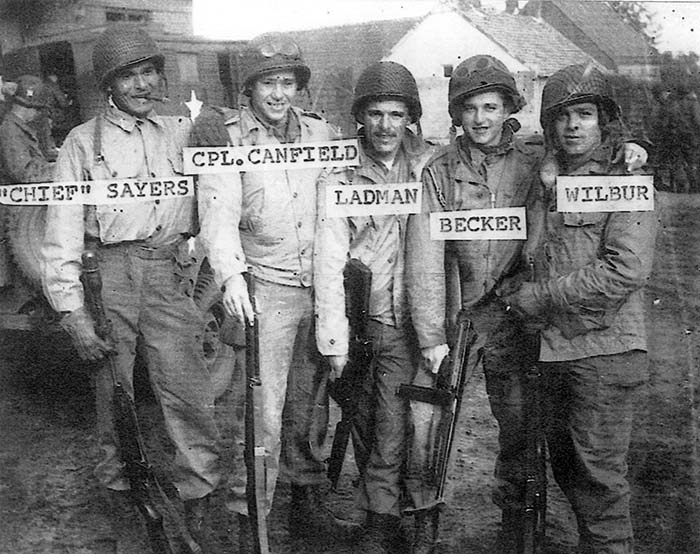
At the outbreak of war, Frank Sayers worked as an in demand hunting guide in Ballpark, Minnesota. Aged 27, married, and exempt from the draft, Frank told his wife that he was going to war. Frank Sayers walked out his front door and joined the Airborne. Rumor had it that Frank descended from the royal blood line of the Ojibway Nation. We called this smiling handsome warrior ‘Chief’ out of respect. Frank fell in love with the M-2 carbine, not as a rifle but as a portable mortar. Frank developed his own technique. At Lady Craven’s estate, Chief fired thousands of grenades perfecting his skill. If it was within his range, Frank Sayers could hit anything that he could see. On the Holland jump, each of us bailed out with extra rifle grenades for Chief strapped to our legs (see SAR ’98). At Heteren, Chief’s amazing accuracy with M-2 rifle grenades helped save all of our lives.
Gene ‘Smokey’ Ladman, Frederick ‘Ted’ Becker, and Bill Canfield were all terrific shots with the Thompson gun. Even the rest of Johnson’s Boys called the S-2 Teams ‘heavily armed’. Bill Canfield lead Col. Johnson’s #2 Recon and Intelligence Team for 501. Smokey Ladman served on Canfield’s team. Ted Becker served on mine. During the war, Bill lost a brother in combat. The Division offered Bill a ticket back to Oklahoma. Sgt. Canfield declined. At the end of the war, Bill returned to his home and lead a good and fruitful life. Bill and I stayed in touch until his death several years ago. Some have called Bill, Dick Thorn, and I ‘hard core S-2’. You betcha. We were and are. Dick Thorn is one of my personal heroes. Occasionally I get a telephone pop quiz from Garland, Texas. I answer the phone ‘Cartledge Furniture’ and a strong voice asks, ‘Where were you on D plus 10 at 3:15 in the afternoon?’ I answer, ‘Outside Carenton near La Braquette. How are you Dick and how is your family?’
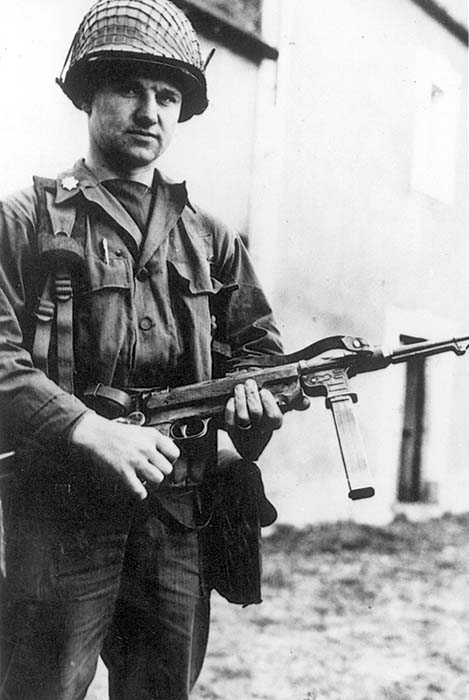
Because of our secret status, Roland Wilbur’s legendary skill with an M-1 languishes in obscurity. It should not. This S-2 rifleman was arguably the finest shot in the U. S. Army with an open sight M-1. The battlefield conduct of this Detroit native has much to teach the modern rifleman. Gifted with extraordinary eyesight, Roland Wilbur believed that John Garand invented the M-1 with him in mind. Each round that Wilbur fired served as practice to improve his skill. Wilbur fired tens of thousands of rounds to push himself to his limits. He had no other competition. After Normandy, a man identified to us as a factory representative came to Lady Craven’s estate to watch Wilbur shoot. He watched with powerful binoculars what Roland Wilbur did with the naked eye. The observer came off the long firing range shaking his head. He stated, ‘This man can shoot his rifle farther and faster than our calculations say that it can be done.’ Wilbur could snap shoot between five and seven hundred yards. He later had recorded kills at that distance at Bastogne.
Wilbur never fired from the same place twice. He never exposed himself longer than to roll over. This roll took place in not much longer than blinking your eye twice. If no one lined up in the sights, Wilbur disappeared. When Wilbur fired, there was one fewer of them. He liked distance head shots. Mark Bando’s interest in the 101st started when he met Rollie in 1973. Through Wilbur, he contacted a number of us, particularly S-2. Mark’s ongoing scholarship has helped preserve the history of the 101st. I commend his books to the reader. Mr. Bando, a Detroit policeman and no pushover, once stated in a complementary fashion that Wilbur was the roughest man that he ever met. I told him that, compared to Nick, Wilbur was a choir boy.
In ‘Saving Private Ryan’ the title character serves in a line company of the 101st. The real Ryan served in a Howard Johnson 501 line company. The Rangers’ first contact with Ryan graphically illustrates one of Howard Johnson’s main rules in the art of war. War confirmed to us the truth of his words. Col. Howard Johnson valued every man under his command and wanted to lose none of us. The reader should not take the following as questioning anyone’s courage, or devotion to duty and country. It simply states a painful fact of war that Col. Johnson taught us.
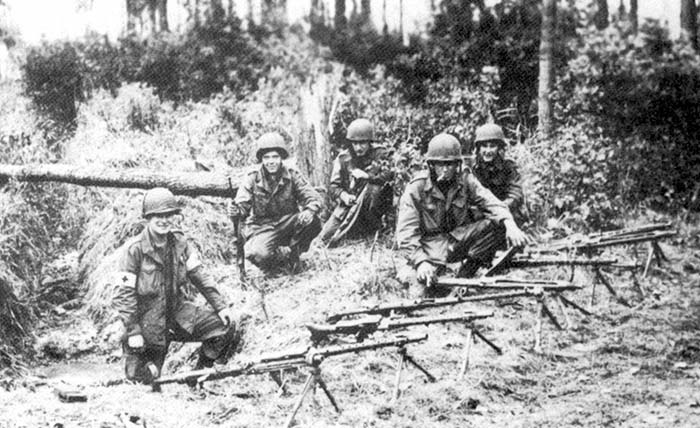
During the five to fifteen minutes when you are in real danger, you have to focus completely and remain completely alert. Your life and the lives of your buddies depend on it. If you live through the first of it, combat teaches you when these times are. About 15% of people killed in combat die unavoidably — i.e. the first mortar round lands unheard at their feet when they are upright — nothing can save them. The majority of the rest die from loss of concentration during critical times — they talk when they should listen, they stand when they should be down, etc. In ‘Saving Private Ryan’ the Germans send a half-track into an unscouted field seeking the enemy. Unfortunately they find them. The track finds remnants of a 101st line company and a squad of Rangers. Mr. Spielberg filmed this perfectly. In combat, being asleep at the wheel does not get you a friendly rap on the windshield from the Highway Patrol. It gets you dead.
The Watch Tower On The Rhine
What follows took place at and near Heteren, Holland in early October 1944. Col. Johnson gave me what we both thought was a routine assignment. He gave 1st Regimental Recon and Intelligence Team the mission of securing the watch tower at Heteren. We got our gear, spread out in a diamond, and took off. We soon left the regiment behind and entered our usual habitat — the place that others call no man’s land. In the following I will tell you of the Watch Tower on the Rhine. I also tell of the American Airborne MP-40’s payback for the British Paratroopers at Arnhem.
The Watch Tower still stands at Heteren, Holland, 15 miles from Arnhem on the Neder (lower) Rhine. The massive tower has stood there since the Middle Ages. It has archery slits and incredibly thick walls. The tower commands an unobstructed view of the nearly flat surrounding countryside. The tower sits beside the Heteren Road that follows the top of the dike. On either side of the road, the earthen edifice gently slopes for hundreds of yards. One side slopes to the Rhine. The other side of the dike slopes toward the low lands, which stretch across the Waal River to Nijmegen.
A Canadian unit held the tower when we arrived. The Germans held the far side of the Rhine. We had traveled miles in front of the advancing line companies to reach the tower. We secured our perimeter and radioed in. The reply told us that Col. Johnson was advancing about a day and a half out. The Canadians left us the next day. We set up forward mortar observation and awaited the line companies. In so doing, we nearly hung ourselves out to dry.
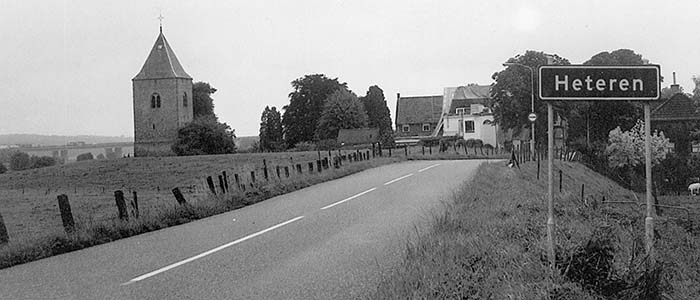
Chief, Waldo Brown, Jack Downs, Ted Becker, and I scouted the terrain. Suddenly, Chief spotted soldiers wearing mouse gray marshaling on the other side of the Rhine. Near the water’s edge, Chief saw the Germans assembling assault boats. Many soldiers gathered near them. It appeared that we were about to take on what we thought was a division. As they endlessly kept coming down to the shore on the Nazi side of the Rhine, we knew. It was a division. They flooded across the Rhine from near Randwijk all the way to Driel, where a fierce battle later took place. The German force numbering about six thousand spread out over several miles. They later pushed in to the right and left of us. The following recounts what happened directly in front of us.
The 10th Panzer Grenadier assembled on the Nazi side of the Rhine. They were green troops. The Germans had built this new division around special diet soldiers — ‘white bread boys’ with ulcers and stomach problems. They had sprinkled in some Waffen SS to butch them up. The reader should know that the German soldier in World War II moved in completely predictable patterns, just as he did in World War I. To save space, I give the reader two quick references.
In the movie ‘Patton’, George C. Scott yells at Rommel and his burning tanks, ‘I read your book!’ Patton had. Rick handed me the copy of ‘A Rifleman Went To War’ autographed by Carlos Hathcock to my grandson. He said, ‘Read this before you send it to Liam.’ I read it and mailed it. The next time that I saw Rick I told him that, other than improving their guns, the Germans hadn’t learned a damned thing in twenty-five years. I have stated exactly the same criticisms of the German soldier as Capt. McBride and for exactly the same reasons. A war apart, we both observed the same conduct.
On the dike, my S-2 Team faced elements of the 10th preparing to launch from the other side of the Rhine. We had to take on the ones in front of us and delay them as long as possible. We radioed our situation to Col. Johnson and got down to business. Was it not that so many of them died because of what we did to them, the following would read like a Ben Hecht screwball comedy. We reached back to Bedford Forrest outside Rome, Georgia for this one. We convinced the green German troops that we were a much larger force than we were.
First, we spread out on the dike and lofted shots at them as they embarked from the other side. Their boats moved erratically. Some of them dove in the river. Then they landed and bunched up. We lofted sporadic shots at them from different spots on the dike. We may have nicked one or two by luck. Then some of them strayed into Chief’s domain. Frank let them have it with rifle grenades, firing four quickly to simulate a battery of mortars. Chief quickly rolled out and dropped below their line of sight. Frank then ran half way down the dike and did it again. We barked orders regularly to no one.
They then started a predictable right probe. They sent a scout out and up. This scout was one of only two German soldiers that I give compliments to. He was very good. His commander wasted him foolishly. When I spotted him moving, I knew where his orders would take him. I maneuvered behind the dike and came up near the place where I knew that he would surface. This German soldier moved skillfully and well. He followed the predictable path that he had been ordered to take. When he popped up near me, I rolled over and killed him. End of right probe. I barked orders and moved.
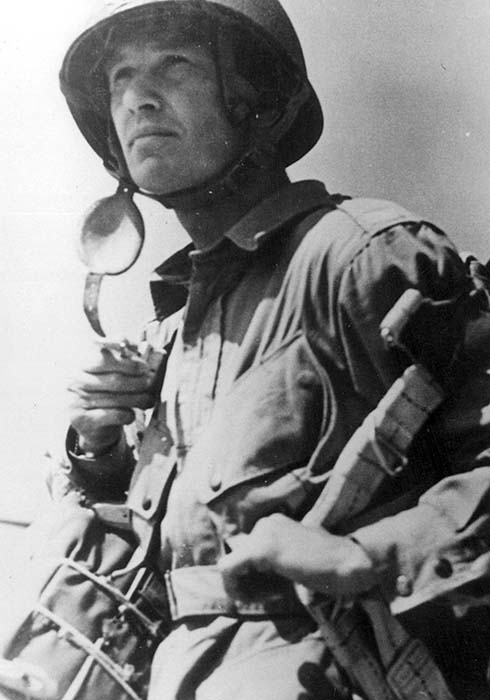
We had run almost out of ammunition by nightfall. We gathered German and American grenades and all went up to the second floor of the watch tower. They couldn’t knock the tower down with anything that they had. They would have to come in and get us. We said to each other that, if they come, we would take as many with us as we can. Strangely, they didn’t come. The next morning, they cooked breakfast and probed again. Chief winged one with a rifle grenade. Becker dropped one with an M-1. They pulled back and thought about it. By this time, we counted our ammunition on our fingers.
By late morning they had dug in on the dike about 500 yards from us. Waldo Brown stated that he had one magazine left for his 45. Waldo said that if we were going out, we were going out in style. Waldo Brown was the only man in S-2 faster than Nick with a 45. He loved that pistol and had saved it for the last. Waldo said, ‘I’m going up on the dike and shoot at the bastards.’ Chief replied, ‘Fifty bucks says you won’t do it.’ Though the Ojibway now operate fine casinos, Frank Sayers had placed a bad bet.
Waldo Brown first donned a British red beret that he had found in the watch tower. He then proceeded to break every known rule of combat. Waldo calmly walked to the top of the dike. Waldo Brown stood erect on top of the dike completely exposed. He screamed profanities at the 10th in German. Waldo then emptied his pistol at them. His pistol empty, Waldo turned his back on them and calmly sauntered off the dike. This was the 10th’s first encounter with Waldo Brown. It wouldn’t be their last.
The Germans finally concluded that there really wasn’t much of anybody on top of the dike. They attacked en mass. This element of 10th decided to attack about fifteen minutes after 501’s 2nd Battalion rolled up behind us on our side of the dike. The 10th attacked up hill on open ground against the crack line companies of 2nd Battalion. Second Battalion proceeded to annihilate them. One of their battalions repaired to the brick factory and established a foothold.
When the smoke cleared, the dike near us looked like a brownish green carpet speckled with mouse gray. We squared off with the 10th in several more battles. After that, we never heard from them in combat again. I took my 38H off their SS Colonel (see SAR ’98). He found my Thompson and didn’t need his pistol anymore. After the battle, I took the paybook off the good soldier that I had killed the day before. I had Col. Howard Johnson and he didn’t. His death illustrates the difference between us. The following is for the professional soldiers who read Small Arms Review.
This German had steeled himself well for battle. He had trained very hard and learned the craft of soldiery. His training showed. Had he worked under our system he might have lived. Col. Johnson’s system varied from his in degree of training and flexibility of command. The Colonel said, ‘Get that tank!’ We said, ‘Yes sir!’ Howard Johnson had shown us more than a dozen ways to kill a tank. He gave the what and left the how to us. With three words, Col. Johnson moved to the next command decision knowing that the panzer would die soon.
Airborne tank killing reached its peak near Wardin, outside Bastogne. German tanks lined up to attack the 101st. A secret kept by us in the intelligence community for nearly 50 years is now general knowledge — ULTRA. Because of ULTRA, many accounts written in the past differ from what you are about to read. A top secret group at an estate outside London had cracked the German code early in the war. We read the German’s mail.
Airborne artillery’s Gen. Anthony McAuliff commanded the 101st at Bastogne. He had provided our 75 Pak guns with special tank killer rounds, proven in Italy. By then our parachute infantry had acquired Gammon grenades. The Gammons contained C-2 plastic explosive and exploded on impact. We fashioned these grenades to baseball and softball size. Any American could throw one. A low fastball blew the tread off. When a high hard one hit properly, the struck panzer shuddered in place. The turret ripped upward like the top of a C-ration can.
The tankers lined up one behind the other at Wardin facing I Company, 3rd Battalion, 501. Some of these tankers had murdered our men at Malmedy. We knew in advance who they were and what they had done. We felt we owed them for the Combat Engineers and the paratroopers of the All American. HDQ sent down three instructions. The first two said to let them in and cut them off.
The third echoed The Blue Eyed Killer at Fredericksburg. The Mighty Stonewall said, ‘Kill them all.’ Airborne artillery usually tied six to eight ropes to the tails of their Pak 75s. The artillerists, generally the largest men in the 101st, could jerk the tails off the ground and run with their guns. The Malmedy tankers barreled through into Wardin in a straight line. They should have known that it went too easily. I Company hung on the rooftops and laid in wait in the buildings like the Mississippi snipers against the Harvard boys. They fought the panzers house to house at point blank range.
I Company took about 40% casualties but stopped the Germans cold. They blew the lead tank flat in the street completely blocking it. The Germans had to go around Wardin while facing Gammons and Pak 75s. Therein lay the success of Bastogne. Though they were under Julian Ewell at the time, I have this to say of those heroic men. The shark killers of I Company 501/3 were the most gallant of Johnson’s Boys.
I later took a night scout toward Wardin. John Pelham would have been very proud of what I saw (see SAR Feb ’98). The fires of the burning German tanks looked like a Boy Scout Jamboree. In short, the 101st threw a Christmas party in Belgium in 1944. The Malmedy tankers insisted on attending. Courteous to a fault, the 101st showed them where the punch bowl was and validated their parking.
The proceeding makes the following point. The grenadier’s commander lost his best man. Col. Howard Johnson gave us flexible orders based on our training. The good soldier’s commander gave him rigid orders from an inflexible book. We knew the book. The good soldier’s commander not only gave him the what but also locked him into the how. That lock got the good soldier killed. Good soldier to good soldier, I hoped that I had squared it for him a bit by killing one of the commanders who had wasted his life.
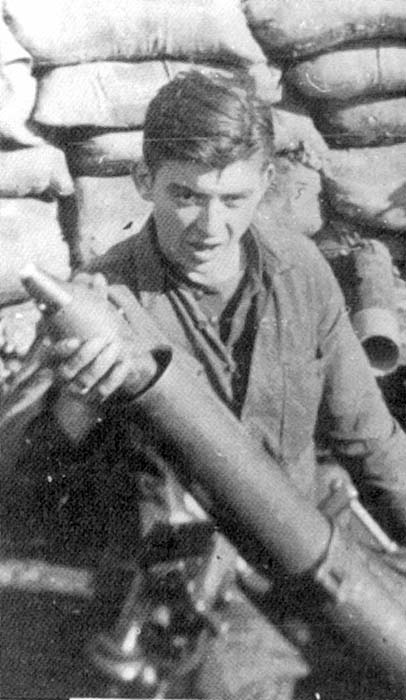
PAYBACK FOR ARNHEM
After securing the watch tower, we started moving down the dike. By this time, the 10th had consolidated their foothold in and around the brick factory. From the brick factory, the Germans hoped to expand their foothold. The British Assault Troops took a crack at the brick factory, fought well but unsuccessfully, and withdrew. First Recon and a 501 line company then took on the brick factory and overran it.
We captured a number of MG-34s, which we called Dutch guns, and MP-40s. We also secured a large quantity of ammunition. Troopers Colbert Collins, Waldo Brown, and Chief Frank Sayers accompanied me on this mission. Frequent Team members Robert O. Nikolai, Roland Wilbur, and Frederick ‘Ted’ Becker served Col. Johnson and Staff Sgt. John Tiller, a very fine soldier from Louisiana, elsewhere on the dike. The four of us in the brick factory hated to see all of that good ammunition go to waste. We thought that we should send it back to those Germans through the barrels of their own guns. Our only problem was the Airborne mortar crews. Mortars present the only real and constant artillery threat to infantry.
An Airborne mortar crew consisted of a four gun battery. Col. Johnson designated 250 rounds per gun per day. Our crews took delight in sniping with mortars at night. My particular mortar crews were the best I ever saw. They could click them in the dark. If an MG-34 cranked up at night, the 81’s turned on the sound. Four down the tubes sent Col. Johnson’s complements to the German gunner. By this time in the Holland Invasion, the Germans used the MP-40 in a defensive manner. If an MP-40 gunner cranked at night, the mortar men knew he was in a patrol. They spread the clicks slightly and dropped four down the tubes simultaneously. The four rounds fell out of the sky within a split second of each other, virtually eliminating any time to duck. A Nazi scream would acknowledge the results. We had heard many more than one. Because of what we had found earlier in the river, we were going to shoot those particular Germans with their own guns. To be safe from our mortars, we knew that we needed an edge.
We took out some wire cutters and began experimenting. We had achieved some success hanging MG-34s out the archery slits of the watch tower. We had chopped springs on 10th Panzer’s guns and arched tracers across the Rhine. We never hit anything but the fireworks kept Herman up at night. The reader should know that what I am about to describe I do not recommend for a fine war souvenir or even one not so fine.
We had the Germans pinned between the brick factory and the Rhine River. It was a duck shoot almost as good as the one that we later had at Bastogne. We cut about two inches from the recoil springs of the MG-34s and the MP-40s. We made no other modifications. The shortened recoil springs changed the sounds of the guns. The different sounds told the mortar crews that Screaming Eagles held the brick factory. Their mortar shells fell past the kilns and tore the earth all the way to the Rhine. As the A6 gunner, I manned the Dutch guns. Waldo Brown, Colbert Collins, and Chief Sayers manned the MP-40s.
We sent those Germans 8 and 9 millimeter all night long. By dawn’s light we saw that the Germans who had not died from mortars had died from their own bullets. Earlier we had fished about five British paratroopers out of the Rhine. Those Germans had forced their British prisoners to carry ammunition to transport boats on the river. They then murdered them. While at Heteren as a guest of the Dutch government in 1988, I told this story to our host. He pointed to a smoke stack farther down the Rhine. He stated that the Germans had shot five more British paratroopers inside that building. We knew what those Germans had done to some British paratroopers who surrendered at Arnhem, barely 15 miles away. We felt that our method of returning German ammunition to those Nazis was quite fitting.
We found the MP-40 to be a good weapon with a flimsy stock. The stock mattered little, as an experienced sub gunner doesn’t use it. Anyone who lost the time that it took to shoulder his weapon against us did not live very long. At Heteren, Holland the 101st Airborne used the MP-40 well against the Germans. I thought that the readers of Frank Iannamico’s book and Small Arms Review might enjoy the account of the Airborne MP-40 for two reasons. First, it tells of a little known but very effective use of the MP-40. Second, and more importantly, the Airborne MP-40 teaches the reader another of Col. Howard R. Johnson’s lessons in the art of war. At night, mortars have ears. They do not have eyes.
Lt. Carl Howard Cartledge Jr.
1st Team Leader
Regimental Recon and Intelligence S-2
501st Parachute Infantry Regiment
101st Airborne
Sources:
‘Saving Private Ryan’ by Mr. Steven Spielberg — now playing
‘The 101st Airborne at Normandy’ and ‘The 101st Airborne: From Holland to Hitler’s Eagles’s Nest’ pictorial histories by Mark Bando. 9025 W. Parkway, Detroit, MI 48239 $23 each, $42 both PPD US.
‘D-Day’ by Dr. Stephen Ambrose, in print and available
‘The Epic of the 101st Airborne’ US Army/ 101st Airborne publication
‘Hell’s Highway’ Chronicle of the Holland Campaign by George E. Koskimaki %101st Airborne Division Assoc. P.O. Box 586, Sweetwater, TN 37874
‘The German MP-40 Maschinepistole’ by Frank Iannamico, % Moose Lake Publishing, 223 Sugar Hill RD, Harmony, ME 04942 207-683-2959
‘A Rifleman Went To War’ by Herbert McBride % Jim Allee, I.D.S.A. Books Piqua, OH
| This article first appeared in Small Arms Review V3N5 (February 2000) |



